OHSU/NFMCPA Survey of Symptoms Other than Pain for FDA Meeting Part 1
 During a couple of weeks at the end of November 2013, NFMPCA members looked at a questionnaire designed by Dr. Rob Bennett. The intent of this questionnaire was to provide information to the Food and Drug Administration (FDA) on common symptoms encountered by fibromyalgia patients, other than pain. This information was to be presented by Jan Chambers at an FDA meeting in December 2013, but due to bad weather the meeting was canceled and was rescheduled for March 26, 2014. This survey provided us with a lot of new and important information regarding the suffering endured by fibromyalgia patients.
During a couple of weeks at the end of November 2013, NFMPCA members looked at a questionnaire designed by Dr. Rob Bennett. The intent of this questionnaire was to provide information to the Food and Drug Administration (FDA) on common symptoms encountered by fibromyalgia patients, other than pain. This information was to be presented by Jan Chambers at an FDA meeting in December 2013, but due to bad weather the meeting was canceled and was rescheduled for March 26, 2014. This survey provided us with a lot of new and important information regarding the suffering endured by fibromyalgia patients.To start with we will examine the basic demographic details. As noted, 3,201 NFMPCA members looked at the questionnaire. It was a rather daunting set of questions which would take 20 to 30 minutes to complete, thus it was not surprising that just over 1,000 would-be participants decided to go no further, or started the survey and gave up partway through. The good news is that 2,187 completed the survey (see table below):
The majority of those surveyed said they had a diagnosis of fibromyalgia (i.e., only 19 patients reported another chronic pain condition as their primary problem).
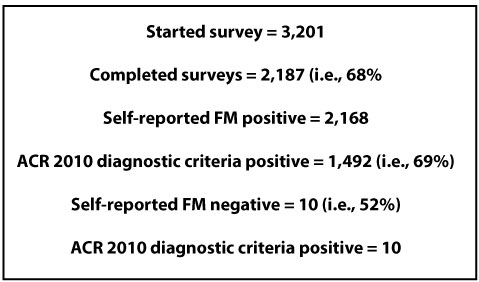
Recently, criteria have been developed for the use in surveys of this kind that enables an investigator to get a good estimate as to who in fact does have fibromyalgia, and who does not (using the ACR 2010 Fibromyalgia Diagnostic Criteria). Of the original 2,168 patients who reported being diagnosed with fibromyalgia, responses from 1,492 (i.e., 69%) survey participants indicate they have fibromyalgia according to the 2010 ACR criteria. Interestingly, 10 of the 19 patients who did not report a diagnosis of fibromyalgia had a positive diagnosis according to the 2010 ACR criteria.
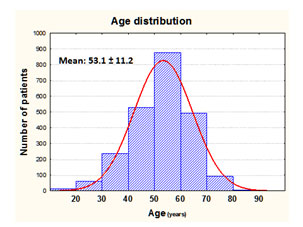 Age
Age
However, as you can see, there was a normal distribution of ages ranging from the late teens to 80-year-olds.
Getting a diagnosis of fibromyalgia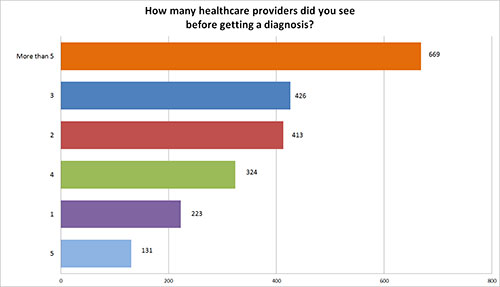 As many people with fibromyalgia symptoms are only too aware, getting a definitive diagnosis of fibromyalgia can be time-consuming and frustrating. One of the questions we asked in the survey was: "How many healthcare providers did you see before getting fibromyalgia?" Approximately one-third of the respondents had to see more than 5 healthcare professionals before getting a definite diagnosis of fibromyalgia.
As many people with fibromyalgia symptoms are only too aware, getting a definitive diagnosis of fibromyalgia can be time-consuming and frustrating. One of the questions we asked in the survey was: "How many healthcare providers did you see before getting fibromyalgia?" Approximately one-third of the respondents had to see more than 5 healthcare professionals before getting a definite diagnosis of fibromyalgia.
Non-pain problems
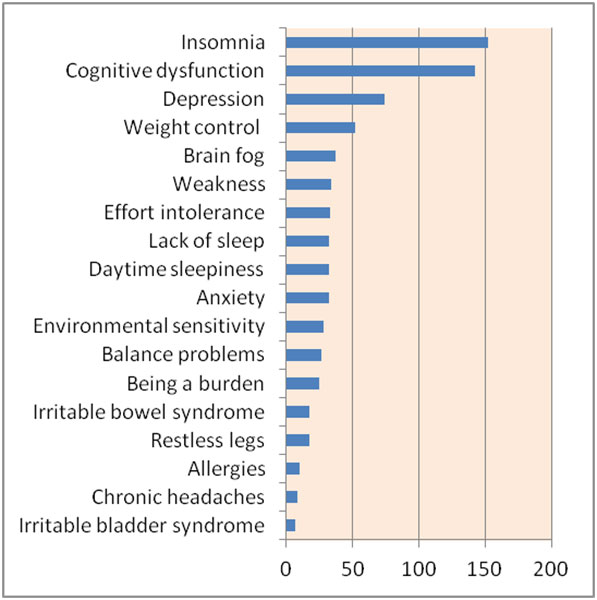
Some of the individual comments were:
- Fearing that being with people will aggravate pain later.
- Feel like I am a burden to my children.
- Feeling a burden and nonproductive, I can't meet simple goals.
- Sometimes feel suicidal
- Feeling as if I am living a "less than" life; not the life I envisioned.
- Feeling exhausted and completely overwhelmed by the smallest tasks.
- Feeling guilty that I can't fix symptoms without medication.
- Feeling hopeless because I cannot be who I was or do the things I love.
- Feeling like a burden due to loss of productivity.
- Feeling that I am not understood and that my physical/energy limitations interfere with living a full life.
- Feeling worthless, that my life no longer matters, having to leave my job because my symptoms were intolerable.
- Fear of getting worse as I get older.
- Unable to do what I used to do, because of brain fog and fear of the unknown.
- Everything seems such an effort.
- Being a burden to my family; my future looks bleak and full of a lifetime of pain.
- Difficulty focusing on the task at hand.
- Afraid to commit to do things because I don't know how capable I will be from day to day.
- Not being as sharp as I used to be, can't remember something I may have been told a day ago.
- Not feeling like I any longer belong with "normal" people.
- Sensitivity to all stimuli. Hard to be around other people due to smells, movement, multiple noise sources.
- There is no more pleasure or enjoyment in life.
- Thinking problems. I "know" what I want to say but can't put it together.
- Withdrawal from life.
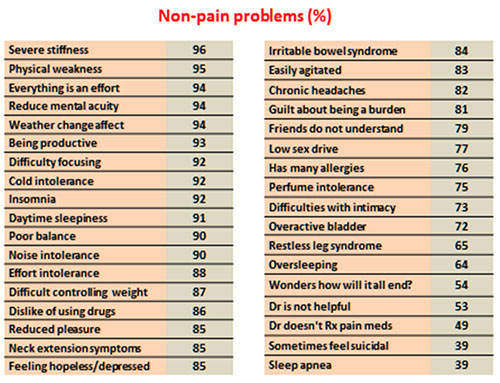
Whereas the last question asked about the non-pain problem that caused most distress, there was also another question regarding the prevalence of non-pain problems in general. As is seen in the chart, stiffness was the most common non-pain problem (96% of respondents reported stiffness). This was shortly followed by physical weakness, effort intolerance, reduced mental abilities and the effect of weather changes. Environmental intolerance to noise, perfumes and cold was reported in 75-92% of subjects. Existential problems such as feeling guilty about being a burden, feeling hopeless and depressed, friends' inability to understand, wondering how it will all end and sometimes feeling suicidal (39%), provide a vivid picture of what it means to be a person with fibromyalgia.
Suicidal ideation has been described in several recent papers; and this current survey adds to the increasing recognition that the frustration of having a poorly recognized chronic pain disorder to lead to thoughts as to “where it all end” and “may be ending my life is one way out.”
What are your sources of information about fibromyalgia?
Medical practice has been forever changed by the ability of patients to consult the Internet. This means that doctors and other health care professionals are not the only fount of knowledge. In general, this is for the good, as many studies have associated education with a better outcome. It certainly appears that fibromyalgia patients are not an exception, with the majority obtaining information from the Internet in addition to consultations with healthcare professionals, as well as reading books and publications.
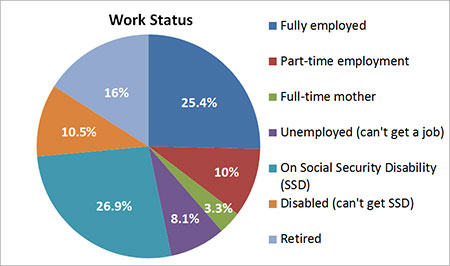
What is your work status?
Fibromyalgia patients often have difficulty remaining productively employed on account increased pain on activity, severe fatigue and problems with memory and concentration. In this survey 25% of the subjects were fully employed and 10% had part-time employment. Eight percent were unemployed and unable to get a job. Some 11% of subjects rated themselves disabled, but could not qualify for Social Security Disability (SSD). However, 27% of subjects were receiving SSD payments. Some 16% subjects were retired. Overall these figures are very similar to published data.
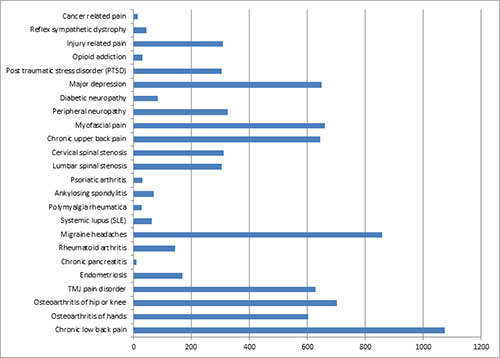
Other diagnoses
Virtually all fibromyalgia patients have developed some other medical problems by the time they reach middle age. As you can see in the current survey over 1,000 of the 2,178 subjects had low back pain and over 800 suffered from migraine headaches. About 30% of subjects had osteoarthritis of the hands knees and hips; in many subjects this will considerably add to the burden of disability. There is a great deal of current interest in the concept that persistent pain arising in the periphery from joints, myofascial trigger points, headaches, etc., lead to the changes in the nervous system characteristic of fibromyalgia. This is often referred to as “central sensitization.”
Dysfunction related to fibromyalgia
In research on fibromyalgia we commonly asked patients how difficult it is to perform simple everyday activities. The chart shown here is taken from the questions in the Fibromyalgia Impact Questionnaire (FIQR). The degree of difficulty is rated on a scale of 0 to 10. You can see that the 3 most problematic tasks are of vacuuming/scrubbing floors, walking continuously for 20 minutes, and going shopping for food or clothes. Interestingly, sitting in a chair continuously for 45 minutes has a rating similar to changing bedsheets or climbing one flight of stairs.
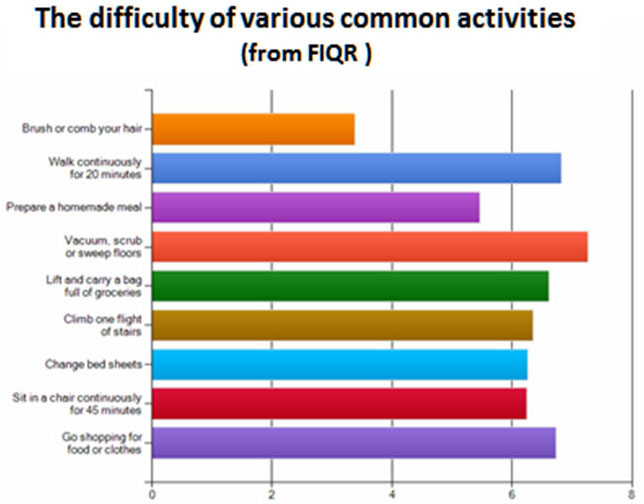
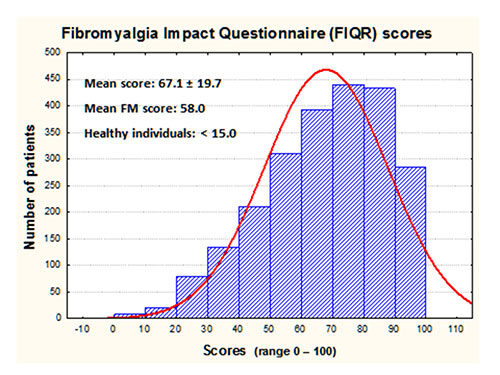
The common activities shown in the activity difficulty chart were taken from the functional component of the FIQR.
In this survey subjects completed the total FIQR with the results shown.
The mean score for the subjects in this survey was 67.1 with a standard deviation of 19.7. This score is significantly higher than the score we typically see in fibromyalgia patients, which is about 58. Note that healthy individuals usually have a total FIQR score of less than 15. There are many potential reasons for the discrepancy between the subjects taking the survey in the typical fibromyalgia patient we see in our clinical studies; for instance subjects who decide to join a fibromyalgia organization such as the NFMCPA may in general have more severe fibromyalgia.
If you would like to take the FIQR yourself, you can find it at: www.fiqr.info
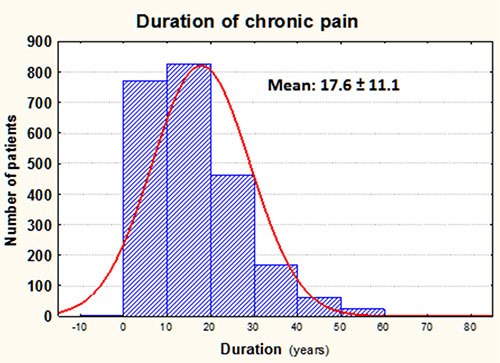
Most patients in the survey had experienced chronic pain for a long time (17.6 years). However, 252 patients had experienced chronic pain for less than 5 years, and 161 patients had had chronic pain for just one year.
MORE TO COME
In Part 2 of the OHSU/NFMCPA Survey to provide information for the FDA Fibromyalgia Public Patient-Focused Meeting, we will explore some very interesting findings relating to the management of fibromyalgia.






